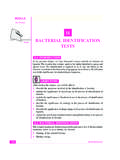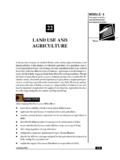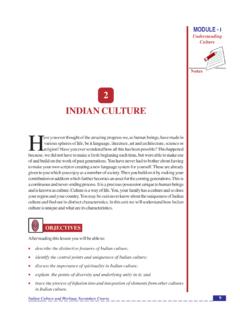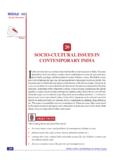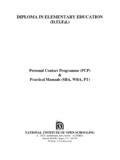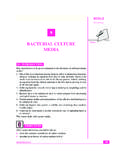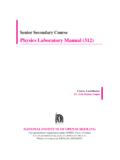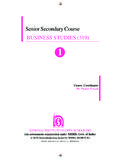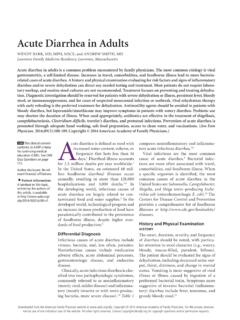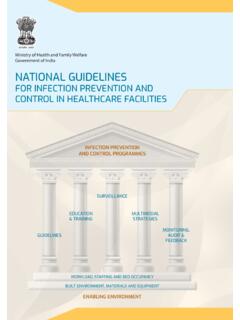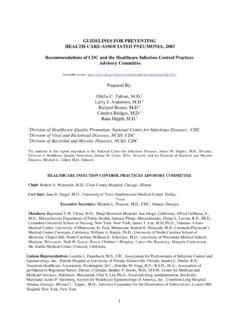Transcription of 8 PATHOGENESIS OF BACTERIAL INFECTION
1 MICROBIOLOGYMODULEP athogenesis of BACTERIAL InfectionMicrobiology 86 Notes8 PATHOGENESIS OF INTRODUCTIONIn this chapter we would focus on how bacterias causes disease to human process of causing disease is termed as PATHOGENESIS . PATHOGENESIS is amulti-factorial process which depends on the immune status of the host, thenature of the species or strain (virulence factors) and the number of organismsin the initial limited number of BACTERIAL species are responsible for the majority ofinfectious diseases in healthy individuals. Due to the success of vaccination,antibiotics, and effective public health measures, until recently, epidemics werefelt to be a thing of the past. Due to the development of antibiotic resistantorganisms, this situation is changing humans are infected with bacteria (the normal flora) living on their externalsurfaces (including the skin, gut and lungs).
2 We are constantly also exposed tobacteria (including air, water, soil and food). Normally due to our host defensesmost of these bacteria are harmless. In compromised patients, whose defensesare weakened, these bacteria often cause opportunistic infectious diseases whenentering the bloodstream (after surgery, catheterization or other treatmentmodalities). When initiated in the hospital, these infectious diseases are referredto as nosocomial. Some common bacteria found in the normal florainclude Staphylococcus aureus, S. epidermidis and Propionibacteriumacnes (found on the skin)and Bacteroides and Enterobacteriaceae found in theintestine (the latter in much smaller numbers).OBJECTIVESA fter reading this chapter, the student will be able to :zdescribe the term Koch s postulates. 87 PATHOGENESIS of BACTERIAL InfectionMICROBIOLOGYMODULEM icrobiologyNoteszdifferentiate colonization and pathogenszexplain steps involved in the BACTERIAL pathogenesiszdescribe toxinszdifferentiate endotoxins and exotoxinszdiscuss the various diseases caused by PATHOGENICITYP athogenicity is the capacity to initiate disease.
3 It requires the attributes oftransmissibility or communicability from one host or reservoir to a fresh host,survival in the new host, infectivity or the ability to breach the new host sdefenses, and virulence, a variable that is multifactorial and denotes the capacityof a pathogen to harm the host. Virulence in the clinical sense is a manifestationof a complex BACTERIAL host relationship in which the capacity of the organismto cause disease is considered in relation to the resistance of the of BACTERIAL pathogensBacterial pathogens can be classified into two broad groups, primary andopportunistic pathogens are capable of establishing INFECTION and causing diseasein previously healthy individuals with intact immunological defenses. However,these bacteria may more readily cause disease in individuals with pathogens rarely cause disease in individuals with intactimmunological and anatomical defenses.
4 Only when such defenses are impairedor compromised, as a result of congenital or acquired disease or by the use ofimmunosuppressive therapy or surgical techniques, are these bacteria able tocause disease. Many opportunistic pathogens, coagulase negativestaphylococci and Escherichia coli, are part of the normal human flora and arecarried on the skin or mucosal surfaces where they cause no harm and mayactually have beneficial effects, by preventing colonization by other potentialpathogens. However, introduction of these organisms into anatomical sites inwhich they are not normally found, or removal of competing bacteria by the useof broad-spectrum antibiotics, may allow their localized multiplication andsubsequent development of above classification is applicable to the vast majority of pathogens;however, there are exceptions and variations within both categories of bacterialpathogens.
5 Different strains of any individual BACTERIAL species can vary in theirgenetic makeup and virulence capacity. For example, the majority of Neisseriameningitidis strains are harmless commensals and considered opportunisticMICROBIOLOGYMODULEP athogenesis of BACTERIAL InfectionMicrobiology 88 Notesbacteria, however, some hypervirulent clones of the organism can cause diseasein a previously healthy individual. Conversely, people vary in their geneticmake-up and susceptibility to invading bacteria. For example, Mycobacteriumtuberculosis is a primary pathogen but does not cause disease in every host QUESTIONS The process of bacteria causing disease is termed as ..2. Ability to affect the host s disease is ..3. Capacity of a pathogen to harm the host is ..4. Pathogens which causes disease in healthy individual is ..5. Pathogens that causes disease in immune compromised individual KOCH S POSTULATES (MODIFIED)Koch forwarded four criteria designed to establish a causal relationship betweena causative microbe and a disease.
6 The postulates were formulated by RobertKoch and Friedrich Loeffler in 1884 and refined and published by Koch in applied the postulates to establish the etiology of anthrax and tuberculosis,and now have been generalized to other The organism must always be found in humans with the infectiousdisease but not found in healthy The organism must be isolated from humans with the infectious disease andgrown in pure The organism isolated in pure culture must initiate disease when re-inoculated into susceptible The organism should be re-isolated from the experimentally 3. and 4. are extremely important in definite proof of the role of agentin human disease. However, this depends on the ability to develop animal modelsthat resemble the human disease. In many cases such models do not process of PATHOGENESIS involves various steps beginning with thetransmission of the infectious agent ( BACTERIAL ) to the host, followed bycolonization of the site.
7 After the colonization of host, the bacteria remainadherent at the site of colonization then invades the host system. After survivingthe host immune system it is ready to cause the disease. 89 PATHOGENESIS of BACTERIAL InfectionMICROBIOLOGYMODULEM icrobiologyNotesSteps involved in the PATHOGENESIS of the bacteria:1. Transmission2. Colonization3. Adhesion4. Invasion5. Survival in the host6. Tissue InjuryTransmissionPotential pathogens may enter the body by various routes, including therespiratory, gastrointestinal, urinary or genital tracts. Alternatively, they maydirectly enter tissues through insect bites or by accidental or surgical trauma tothe skin. Many opportunistic pathogens are carried as part of the normal humanflora, and this acts as a ready source of INFECTION in the compromised host ( cases of AIDS or when the skin barrier is breached). For many primarypathogens, however, transmission to a new host and establishment of infectionare more complex establishment of a stable population of bacteria on the host s skin or mucousmembranes is called colonization.
8 For many pathogenic bacteria, the initialinteraction with host tissues occurs at a mucosal surface and colonizationnormally requires adhesion to the mucosal cell surface. This allows theestablishment of a focus of INFECTION that may remain localized or maysubsequently spread to other of BACTERIAL InfectionMicrobiology 90 NotesAdhesionAdhesion is necessary to avoid innate host defense mechanisms such asperistalsis in the gut and the flushing action of mucus, saliva and urine, whichremove non-adherent bacteria. For bacteria, adhesion is an essential preliminaryto colonization and then penetration through tissues. Successful colonizationalso requires that bacteria are able to acquire essential nutrients in particulariron for growth. At the molecular level, adhesion involves surface interactionsbetween specific receptors on the mammalian cell membrane (usuallycarbohydrates) and ligands (usually proteins) on the BACTERIAL surface.
9 Thepresence or absence of specific receptors on mammalian cells contributessignificantly to tissue specificity of INFECTION . Nonspecific surface properties ofthe bacterium, including surface charge and hydrophobicity, also contribute tothe initial stages of the adhesion process. Several different mechanisms ofbacterial adherence have evolved, all utilizing specialized cell surface organellesor macromolecules, that help to overcome the natural forces of repulsion thatexist between the pathogen and its target cell. Many bacteria express pili (orfimbriae) which are involved in mediating attachment to mammalian cellsurfaces. Different strains or species of bacteria produce different types of piliwhich can be identified on the basis of antigenic composition, morphology andreceptor is penetration of host cells and tissues (beyond the skin and mucoussurfaces), and is mediated by a complex array of molecules, often described as invasins.
10 These can be in the form of BACTERIAL surface or secreted proteinswhich target host cell molecules (receptors).Once attached to a mucosal surface, some bacteria, Corynebacteriumdiphtheriae or Clostridium tetani, exert their pathogenic effects withoutpenetrating the tissues of the host. These produce biologically active moleculessuch as toxins, which mediate tissue damage at local or distant sites. For anumber of pathogenic bacteria, however, adherence to the mucosal surfacerepresents only the first stage of the invasion of tissues. Examples of organismsthat are able to invade and survive within host cells include Mycobacteria,Salmonella, Shigella and others. The initial phase of cellular invasion involvespenetration of the mammalian cell membrane and many intracellular pathogensuse normal phagocytic entry mechanisms to gain access. Inside the cell, theybecome surrounded by host cell-derived membrane vesicles.
